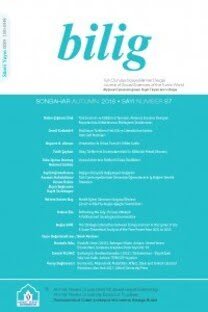Ahıska Türklerinde Türkçe-Rusça Kod Değiştirme Deseni ve Temel Dil Çerçeve Modeli
Ahıska Türkleri, kod değiştirme, Temel Dil Çerçeve Modeli, Türkçe-Rusça iki dillilik, Türk diasporası
Code-Switching Pattern of Turkish- Russian Bilingual Ahıska Turks and Matrix Language Frame Model
Ahıska Turks, code-switching, Matrix Language Frame Model, Turkish-Russian bilingualism, Turkish diaspora,
___
- Ahmed, Oktay. “Copied Verbs in Turkish Dialects of Macedonia.” The Uppsala Meeting, ed. Eva Csato, Birsel Karakoç, and Astrid Menz, Harrassowitz Verlag, 2016, pp. 9-18.
- Aqtay, Gulayhan. “Adjectives in Modern Kazakh.” Turkey, Kazakhstan and the Crimea: Ten Years of Turkology in Poznan, ed. Henryk Jankowski, Wydawnictwo Naukowe, 2013, pp. 37-47.
- Auer, Peter, and Raihan Muhamedova. “Embedded Language and Matrix language in Insertational Language Mixing: Some Problematic Cases.” Rivista di Linguistica, vol. 17, no. 1, 2005, pp. 35-54.
- Aydıngün, Ayşegül. “Creating, Recreating and Redefining Ethnic Identity: Ahıska/ Meskhetian Turks in Soviet and Post-Soviet Contexts.” Central Asian Survey, vol. 21, no. 2, 2002, pp. 185-197.
- Aydıngün, Ayşegül, et al. Meskhetian Turks: An Introduction to Their History, Culture, and Resettlement Experiences. Cultural Orientation Resource Center-Culture Profile. 2006.
- Backus, Ad. Patterns of Language Mixing. Harrasowitz Werlag, 1992.
- Backus, Ad. Two in One. Tilburg University Press, 1996.
- Backus, Ad. “Codeswitching as One Piece of the Puzzle of Language Exchange.” Multidisciplinary Approaches to Code-switching, ed. Ludmila Isurin, Donald Winford, and Kees de Bot, John Benjamin Publishing, 2009, pp. 307-336.
- Dunn, John, and Shamil Khairov. Modern Russian Grammar. Routledge, 2009.
- Forker, Diana. “Sanzhi-Russian Code-switching and the Matrix Language Frame Model.” International Journal of Bilingualism, no. 23, 2019, pp. 1448-1468.
- Gardner-Chloros, Penelope. Code-switching. Cambridge University Press, 2009.
- Grosjean, François. “The Bilingual’s Language Modes.” One Mind, Two Languages: Bilingual Language Processing, ed. Janet Nicol. Blackwell, 2001, pp. 1-22.
- Haugen, Einar. “The Analysis of Linguistic Borrowing.” The Ecology of Language, ed. Anwar S. Dill. Stanford University Press, 1972, pp. 79-109.
- İnan, Kayhan. “Bilingualism, Language Choice, and Language Loyalty in Ahıska Turks in Kyrgyzstan in Terms of the Generation Variable.” TEKE, vol. 9, no. 4, 2020, pp. 1557-1580.
- Jankowski, Henryk. “Kazakh in Contact with Russian in Modern Kazakhstan.” Turkic Languages, no. 16, 2012, pp. 25-67.
- Johanson, Lars. Türkçe Dil İlişkilerinde Yapısal Etkenler. ed. Nurettin Demir, Türk Dil Kurumu, 2007.
- Johanson, Lars. “Remodeling Grammar Copying, Conventionalization, Grammaticalization.” Language Contact and Contact Languages, ed. Peter Siemund, and Noemi Kintana, John Benjamins, 2008, pp. 61-79.
- Killi Yılmaz, Gülsüm. “Khakassian-Russian Code-switching in the Stories by Ilya Topoyev.” Journal of Modern Turkish Studies, no. 11, 2014, pp. 208-234.
- Kreindler, Isabelle. “The Soviet Deported Nationalities: A Summary and an Update.” Soviet Studies, vol. 38, no. 3, 1986, pp. 387-405.
- MacSwan, Jeff. “Codeswitching and Generative Grammar: A Critique of the MLF Model and Some Remarks on Modified Minimalism.” Bilingualism: Language and Cognition, vol. 8, no. 1, 2005, pp. 1- 22.
- Matras, Yaron. Language Contact. Cambridge University Press, 2009.
- Menz, Astrid. “Slavic Language Influence on Gagauz.” bilig, vol. 24, 2003, pp. 23-44.
- Muhamedova, Raihan. “Remarks on the Kazakh Discourse Marker žaŋaγï.” Trans-Turkic Studies, ed. Matthias Kappler, Mark Kirchner, and Peter Ziem, Türk Dilleri Araştırmaları Dizisi, 2010, pp. 441-454.
- Muysken, Pieter. Bilingual Speech: A Typology of Code-mixing. Cambridge University Press, 2000.
- Myers-Scotton, Carol. “Comparing Codeswitching and Borrowing.” Journal of Multilingual and Multicultural Development, no. 13, 1992, pp. 19-39.
- Myers-Scotton, Carol. “Constructing the Frame in Intrasentential Codeswitching.” Multilingua, vol. 11, no. 1, 1992, pp. 101-127.
- Myers-Scotton, Carol. Dueling Languages. Oxford University Press, 1993.
- Myers-Scotton, Carol. Multiple Voices: An Introduction to Bilingualism. Blackwell Publishing, 2006.
- Myers-Scotton, Carol, and Janice Jake. “A Universal Model of Code-switching and Bilingual Language Processing and Production.” The Cambridge Handbook of Linguistic Code-switching, ed. Barbara E. Bullock, and Almeida J. Toribio, Cambridge University Press, 2009, pp. 336-357.
- Myers-Scotton, Carol, and Janice Jake. “Revisiting the 4-M Model: Codeswitching and Morpheme Election at the Abstract Level.” International Journal of Bilingualism, no. 21, 2017, 340-366.
- Myers-Scotton, Carol, and John Okeju. “Neighbors and Lexical Borrowing.” Language, no. 49, 1973, pp. 871-889.
- Petrou, Maria. “Lexical Borrowing and Code-switching in Turkish Varieties of Western Thrace.” Ankara Papers in Turkish and Turkic Linguistics, ed. Deniz Zeyrek, and Çiğdem Sağın Şimşek, Harrassowitz Werlag, 2015, pp. 4440-4522.
- Süleymanov, Mikail. Personal Interview. 17 May 2017.
- Şener, Serkan. Code-switching of Turkish-German Bilinguals: A Structural Analysis. Master Thesis. Ankara: Ankara University, 1998.
- Treffers-Daller, Jeannie. “Towards a Uniform Approach to Code-switching and Borrowing.” Papers for the Workshop on Constraints, Conditions, and Models, European Science Foundation, 1991, pp. 259-279.
- Trier, Tom, and Andrei Khanzin. “Introduction.” Meskhetian Turks at a Crossroads: Integration, Reparation or Resettlement? ed. Tom Trier, and Andrei Khanzin, Lit Verlag, 2007, pp. 1-42.
- Whitehouse, Mark. “Politics of Persecution.” moscowtimes.com, The Moscow Times, 24 January 1998, http://old.themoscowtimes.com. Accessed 18 November 2019.
- Yazıcı Ersoy, Habibe. “Code-switching Among Languages: The Instance of Bashkir Literary Language.” Dil Araştırmaları, no. 21, 2017, pp. 61-77.
- ISSN: 1301-0549
- Yayın Aralığı: Yılda 4 Sayı
- Başlangıç: 1996
- Yayıncı: Ahmet Yesevi Üniversitesi
Sürdürülebilir Güvenlik Çerçevesinde Türkiye’nin İklim Politikaları
Melgunov’a Göre 19. Yüzyılda İran’da Türkmen Boyları
Mete Yusuf USTABULUT, Emrah BOYLU, Umut BAŞAR
Saltanat ve Hilafetin Kaldırılışının İspanya Basınındaki Yankıları
Ahıska Türklerinde Türkçe-Rusça Kod Değiştirme Deseni ve Temel Dil Çerçeve Modeli
Safevî Devleti’nden Sonra İran’da Siyasî İktidarların Meşruiyet Arayışları
